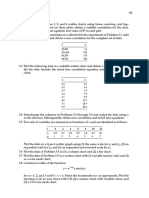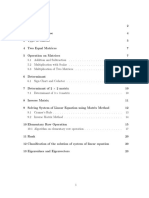4.11 HW Machine Learning SOLUTION
4.11 HW Machine Learning SOLUTION
Uploaded by
ahihi channelCopyright:
Available Formats
4.11 HW Machine Learning SOLUTION
4.11 HW Machine Learning SOLUTION
Uploaded by
ahihi channelCopyright
Available Formats
Share this document
Did you find this document useful?
Is this content inappropriate?
Copyright:
Available Formats
4.11 HW Machine Learning SOLUTION
4.11 HW Machine Learning SOLUTION
Uploaded by
ahihi channelCopyright:
Available Formats
4.
11 HW Machine Learning SOLUTIONS
Q1: Discuss and demonstrate in detail how an accurate classifier can be found for the following training data
shown in 2D.
Many possible kernel transformations can be
done, this one below is from the LMS x y z=x+y2 shape
4 2 8 triangle
1 3 10 triangle
3 3 12 triangle
6 3 15 triangle
8 4 24 triangle
2 5 27 triangle
4 5 29 circle
6 5 31 circle
4 6 40 circle
6 7 55 circle
z=(x-5)2+(y-6)2 will also work as a kernel
transformation for this dataset x y z=(x-5)2+(y-6)2 shape
where z > 6 forms a hyperplane separator which 4 2 17 triangle
1 3 25 triangle
is a plane.
3 3 13 triangle
6 3 10 triangle
8 4 13 triangle
2 5 10 triangle
4 5 2 circle
6 5 2 circle
4 6 1 circle
6 7 2 circle
The data is not linearly separable so a perceptron is not suitable for classification in this case. An SVM can be used
and a transformation function (kernel) can be applied to the data for example z=x+y2 then a linear classifier can be
applied in the transformed space, this will result in a decision boundary hyperplane in 3D for example z > 28 are
circles. (NOTE: Other valid kernel transformations may exist)
Q2: The Abacus company came up with the following hyperplane as shown in the diagram below. What are the
issues with the result?
If the training data was sufficient and representational then underfitting has
occurred on the training data as the hyperplane boundary is not classifying
correctly and it is unlikely that the predictions on new data will be correct.
There may not have been enough training data, or it may not have been
representational of the population to determine, there may be outliers that
are misclassified.
Consider the following table for an automated seat belt fastener alert in a car which is making decisions based on a
function in a single hidden neuron that accepts weighted input from two binary sensor inputs and a conditional
function applied to them.
Input1 =(weight sensor on seat > 1kg) Input2= (seatbelt on for seat) Show Alert =
X1 X2 NOT(NOT(Input1) OR (Input2))
0 0 0
0 1 0
1 0 1
1 1 0
CHES Algorithmics Unit 4
4.11 HW Machine Learning SOLUTIONS
Q3: Draw a clearly labelled neural network and its structures that represents the automated seat belt fastener
alert decision.
Show input, hidden and output layers
The inputs and their alert outcomes for the seat belt alert mechanism can also be shown on a cartesian plane below.
Q4: Can this seat belt alert be represented by a perceptron neural network and/or a support vector machine or
both? Explain your answer.
• The inputs and their results are linearly separable when plotted on a cartesian plane so can be decided using a
support vector machine. The SVM classifier would be a hyperplane that separates the Nos and Yesses with the
biggest margin possible.
• The inputs and their results are linearly separable as the output of the function in the hidden layer is
true/false and can also be represented by a perceptron neural network.
• Since the only data points possible for this scenario are Boolean values (0,1), (0,0), (1,1) and (1,0) a
deterministic algorithm can easily determine the seat belt alert.
If (NOT(NOT(Input1) OR (Input2))) then
Show alert
End if
Q5: If you answered yes to any of the previous then show the classifiers for each Machine Learning method(s).
• Perceptron Neural Network Binary classify O=( true if w1x1 + w2x2 > 0, false if w1x1 + w2x2=0)
• SVM hyperplane to classify the two types of output with the biggest margin possible would go through the
cartesian points (0.5,0) and (1,0.5)
Hyperplane gradient=1 w1(0.5)1-w1(0)-b=0
Weight vector gradient = -1 w1(0)-w1(0)-b=-1 b=1
hence w1=-w2 -w1=w2 w1(1)-w1(0)-b=+1 w1=2
w1x1+w2x2-b=0 on hyperplane w2=-2
w1x1+w2x2-b=-1 for (0,0),(1,1)
w1x1+w2x2-b=1 for (1,0) 2x1-2x2-1=0 defines
hyperplane for SVM
CHES Algorithmics Unit 4
You might also like
- Advanced Mathematical ConceptsDocument568 pagesAdvanced Mathematical ConceptsSi Mi86% (7)
- Pine Script v5 User ManualDocument583 pagesPine Script v5 User ManualAnthony Usoro100% (1)
- Solution Manual For Differential Equations and Linear Algebra 4th Edition by Goode ISBN 0321964675 9780321964670Document36 pagesSolution Manual For Differential Equations and Linear Algebra 4th Edition by Goode ISBN 0321964675 9780321964670jenniferwatersgbrcixdmzt100% (35)
- Precalculus Mathematics For Calculus 7th Edition Stewart Redlin Watson Test BankDocument41 pagesPrecalculus Mathematics For Calculus 7th Edition Stewart Redlin Watson Test Bankpaul97% (35)
- Plane ExtractionDocument11 pagesPlane ExtractiondanielsturzaNo ratings yet
- Chart Patterns ForexDocument16 pagesChart Patterns Forexnishitsardhara83% (6)
- Question Bank 2023 Final All QuestionsDocument78 pagesQuestion Bank 2023 Final All QuestionsBinit KarmakarNo ratings yet
- ML Exercises 7 8 enDocument5 pagesML Exercises 7 8 enThắng Phùng ĐìnhNo ratings yet
- WAJA 2009: Additional Mathematics Form FiveDocument24 pagesWAJA 2009: Additional Mathematics Form FivecandylimNo ratings yet
- KRKRDocument5 pagesKRKRbertinNo ratings yet
- Artificial Neural Networks: - ApplicationDocument25 pagesArtificial Neural Networks: - Applicationgreyz0zetrocNo ratings yet
- Lecture 9Document4 pagesLecture 9Lokeshraja SundaramNo ratings yet
- Vectors.: Points. For The Critical Points, Carry Out Simple Calculations For The Decision What Needs To BeDocument10 pagesVectors.: Points. For The Critical Points, Carry Out Simple Calculations For The Decision What Needs To Beasdaras123No ratings yet
- Tutorial MatlabDocument89 pagesTutorial Matlab14002454 MUHAMMAD RAIZA PRATAMANo ratings yet
- 7 LastDocument28 pages7 LastNand KumarNo ratings yet
- Graphs of Functions of Two VariablesDocument11 pagesGraphs of Functions of Two VariablesEVANS KIPNGETICHNo ratings yet
- Rob Lect5Document23 pagesRob Lect5Ahmed ElkhateebNo ratings yet
- Magesh 21BMC026 Matlab Task 8 CompletedDocument103 pagesMagesh 21BMC026 Matlab Task 8 CompletedANUSUYA VNo ratings yet
- Finding A Quadratic Function With A Parabola - StudyPugDocument8 pagesFinding A Quadratic Function With A Parabola - StudyPugJemeraldNo ratings yet
- PST 3dplotDocument67 pagesPST 3dplotMedina HalidovićNo ratings yet
- WAJA 2009: Additional Mathematics Form FourDocument17 pagesWAJA 2009: Additional Mathematics Form Fourqh46wnzbgmNo ratings yet
- Javakuka: Create KUKA Robot Language (KRL) Codes With JavaDocument28 pagesJavakuka: Create KUKA Robot Language (KRL) Codes With JavaSergei KublanovNo ratings yet
- SEM 2 - Decision-Science-Dec 2022Document11 pagesSEM 2 - Decision-Science-Dec 2022lsuryawanshiforcnxNo ratings yet
- hw4 SolDocument3 pageshw4 SolkalaputraNo ratings yet
- Non-Linear Function & Application: (Chapter 4)Document36 pagesNon-Linear Function & Application: (Chapter 4)Steven GifferdNo ratings yet
- FinalDocument27 pagesFinalAbhishek KamalNo ratings yet
- PPT6 Matrix AlgebraDocument15 pagesPPT6 Matrix AlgebraRano AcunNo ratings yet
- Classs Xii-MatrixDocument38 pagesClasss Xii-MatrixlmajhiNo ratings yet
- Graphics 05 Mid-Point CircleDocument24 pagesGraphics 05 Mid-Point CircleTanvir AlamNo ratings yet
- Schwarz-Christoffel Toolbox User's Guide: 1 Executive SummaryDocument26 pagesSchwarz-Christoffel Toolbox User's Guide: 1 Executive Summarychenwx21No ratings yet
- Question 1 - Harris Corner Detection (20 Points)Document7 pagesQuestion 1 - Harris Corner Detection (20 Points)HiroNo ratings yet
- Project 1: Numerical Method Programming (Python - Monte Carlo)Document12 pagesProject 1: Numerical Method Programming (Python - Monte Carlo)surianahNo ratings yet
- WAJA 2009: Additional Mathematics Form FourDocument17 pagesWAJA 2009: Additional Mathematics Form Fourqh46wnzbgmNo ratings yet
- 4-6 Remediation WorksheetsDocument10 pages4-6 Remediation WorksheetsMary Joy LugaNo ratings yet
- PSLP Lab File 1Document50 pagesPSLP Lab File 1techgur44No ratings yet
- Tutorial On Matlab: 1. Matrix AlgebraDocument15 pagesTutorial On Matlab: 1. Matrix AlgebraadnanNo ratings yet
- Assignment Dierence and Dierential Equations 2009-2010: Group 3Document22 pagesAssignment Dierence and Dierential Equations 2009-2010: Group 3Jan Jakob LameijerNo ratings yet
- SharingDocument2 pagesSharingGeorge PuiuNo ratings yet
- Matrix 2Document24 pagesMatrix 2AsyrieNo ratings yet
- Tutorial 3Document6 pagesTutorial 3Snehita NNo ratings yet
- Solutions To Homework Assignment 1: 36-462 January 2009Document12 pagesSolutions To Homework Assignment 1: 36-462 January 2009Mainak ChatterjeeNo ratings yet
- Using Parametric EquationsDocument5 pagesUsing Parametric EquationswolfretonmathsNo ratings yet
- SCT EndSem 2021Document4 pagesSCT EndSem 2021sudip modakNo ratings yet
- Circle Mid PointDocument20 pagesCircle Mid Pointkushagra srivastava0% (1)
- T2 MatLabDocument7 pagesT2 MatLabcarlos.villegasNo ratings yet
- Assignment Responsion 08 Linear Regression Line: By: Panji Indra Wadharta 03411640000037Document11 pagesAssignment Responsion 08 Linear Regression Line: By: Panji Indra Wadharta 03411640000037Vivie PratiwiNo ratings yet
- Assignment Responsion 08 Linear Regression Line: By: Panji Indra Wadharta 03411640000037Document11 pagesAssignment Responsion 08 Linear Regression Line: By: Panji Indra Wadharta 03411640000037Vivie PratiwiNo ratings yet
- Math 2301Document9 pagesMath 2301Sifat UllahNo ratings yet
- Section 10-5 Parametric EquationsDocument11 pagesSection 10-5 Parametric EquationsBhupesh KumarNo ratings yet
- Chapter 1Document49 pagesChapter 1Wai Yi KanNo ratings yet
- Course OverviewDocument15 pagesCourse OverviewEduardo Pereira BártoloNo ratings yet
- Week2 L4 5 Limits of Transcendental FunctionsDocument30 pagesWeek2 L4 5 Limits of Transcendental FunctionsEunice Jane AcostaNo ratings yet
- Decision MakingDocument10 pagesDecision Makingrohit chaudharyNo ratings yet
- A Brief Introduction to MATLAB: Taken From the Book "MATLAB for Beginners: A Gentle Approach"From EverandA Brief Introduction to MATLAB: Taken From the Book "MATLAB for Beginners: A Gentle Approach"Rating: 2.5 out of 5 stars2.5/5 (2)
- Robot Manipulators: Modeling, Performance Analysis and ControlFrom EverandRobot Manipulators: Modeling, Performance Analysis and ControlNo ratings yet
- A-level Maths Revision: Cheeky Revision ShortcutsFrom EverandA-level Maths Revision: Cheeky Revision ShortcutsRating: 3.5 out of 5 stars3.5/5 (8)
- APPENDECTOMYDocument12 pagesAPPENDECTOMYayouNo ratings yet
- Alstrom Series ASTEG Steam Generator BrochureDocument2 pagesAlstrom Series ASTEG Steam Generator BrochureAnonymous 7xHNgoKE6eNo ratings yet
- Book Review: Screw It, Let's Do It - Lessons in LifeDocument8 pagesBook Review: Screw It, Let's Do It - Lessons in LifeAmish MehtaNo ratings yet
- TR-22001-I-Mtl Testing of Indian Velcro Hook-Loop-ExistingDocument3 pagesTR-22001-I-Mtl Testing of Indian Velcro Hook-Loop-ExistingAshraaf aushiNo ratings yet
- Span Drive Install ManualDocument19 pagesSpan Drive Install ManualChanpory RithNo ratings yet
- Good Woodworking February 2018Document92 pagesGood Woodworking February 2018kaka_02468100% (3)
- Psicoeducazione 2 PDFDocument16 pagesPsicoeducazione 2 PDFFlavia CaturanoNo ratings yet
- G.R. No. 137296 June 26, 2003 PEOPLE OF THE PHILIPPINES, Plaintiff-Appellee, DIONISIO VICENTE y QUINTO, Accused-AppellantDocument11 pagesG.R. No. 137296 June 26, 2003 PEOPLE OF THE PHILIPPINES, Plaintiff-Appellee, DIONISIO VICENTE y QUINTO, Accused-AppellantAnna Lee Acsibar CarbonilNo ratings yet
- Inventory MGT UltraTech Cement ST Joseph's 2024Document102 pagesInventory MGT UltraTech Cement ST Joseph's 2024ahmedaljeelaniNo ratings yet
- AQA Set 3 Foundation GCSE Math Paper 1Document22 pagesAQA Set 3 Foundation GCSE Math Paper 1bagaj11052No ratings yet
- List of First Selection and Waiting List Candidates For Climate Science and TechnologyDocument3 pagesList of First Selection and Waiting List Candidates For Climate Science and TechnologySoumya Satyakanta SethiNo ratings yet
- Analysis of The Factors Affecting Customer PrefereDocument14 pagesAnalysis of The Factors Affecting Customer Prefere20uco648No ratings yet
- LP 19 JuneDocument2 pagesLP 19 JuneIlham IzzatNo ratings yet
- Exercicio Aulas 10 A 13Document7 pagesExercicio Aulas 10 A 13kaueNo ratings yet
- Intro Script AhmDocument2 pagesIntro Script Ahmjames domingoNo ratings yet
- Case2: Liulishuo: AI English TeacherDocument3 pagesCase2: Liulishuo: AI English TeacherSoubhagya DashNo ratings yet
- Free FeesDocument328 pagesFree FeesYash GuptaNo ratings yet
- Clare Ramsdell: Professional ExperienceDocument2 pagesClare Ramsdell: Professional Experienceapi-612675478No ratings yet
- Legal and Forensic Medicine Notes PDFDocument16 pagesLegal and Forensic Medicine Notes PDFYor Cabz50% (4)
- Crowfunding ReportDocument103 pagesCrowfunding ReportSeminarski RadoviNo ratings yet
- CHN Idb 2DDocument8 pagesCHN Idb 2DJohn Dave V. VillarmenteNo ratings yet
- Pioneers of Filipino PsychologyDocument8 pagesPioneers of Filipino PsychologyTour- Chua, Sharrie LeighNo ratings yet
- Lampiran 3 SpssDocument25 pagesLampiran 3 SpssyulianaNo ratings yet
- Everywhere at The End of TimeDocument9 pagesEverywhere at The End of TimeferrylgNo ratings yet
- Code of Ethics: Bustamante, Guianne Carlo B. CE195 - C2 CE-4 / 2010100616 April 26, 2014 Engr. Geoffrey CuetoDocument4 pagesCode of Ethics: Bustamante, Guianne Carlo B. CE195 - C2 CE-4 / 2010100616 April 26, 2014 Engr. Geoffrey CuetoGuianne Carlo BustamanteNo ratings yet
- The Effects of Essence-Formed Cosmetic Ingredients Containing The GalactomycesDocument8 pagesThe Effects of Essence-Formed Cosmetic Ingredients Containing The GalactomycesLwsynergylab OfficialNo ratings yet
- Science Form 3 Chapter 1-3Document7 pagesScience Form 3 Chapter 1-3Darren Ng100% (4)
- Carbonx Ultimate Dj77-LoresDocument2 pagesCarbonx Ultimate Dj77-Loresme100% (1)

























































































